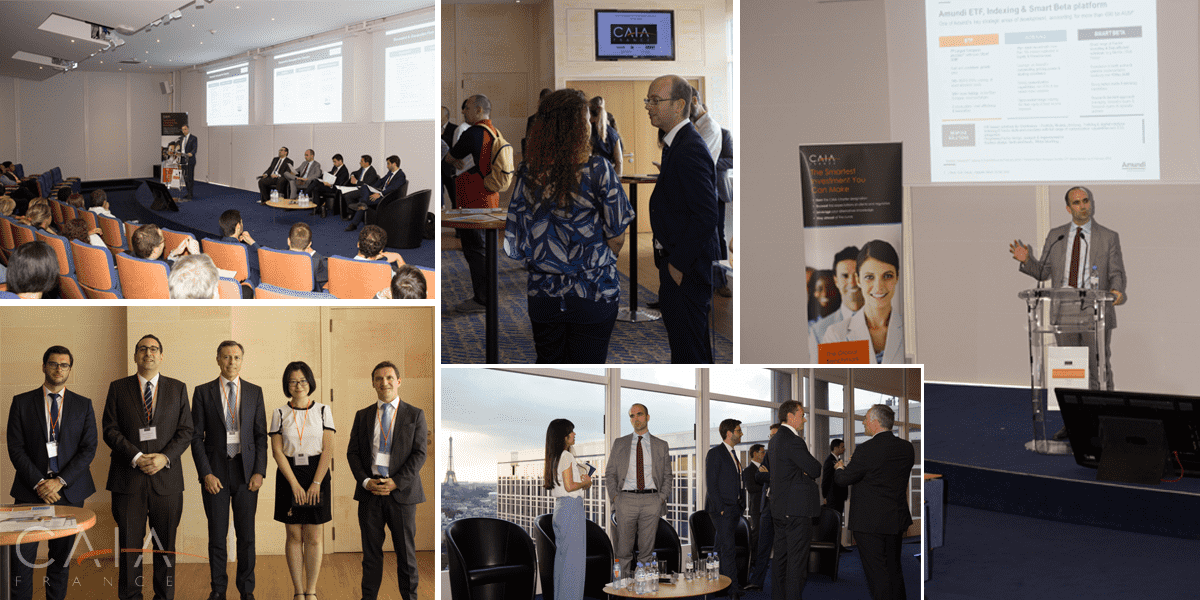On May 30, CAIA France sponsored a panel discussion on absolute return strategies, held at the headquarters of Amundi Asset Management, on the Boulevard Pasteur in Paris.
Frederic Hoogveld, the head of investment specialists, index and smart beta for Amundi, spoke that evening on dynamic factor allocation.
As a review: “factor allocation” refers to models that build upon the classic capital asset pricing model. The CAPM only acknowledges one factor: it posits that (at least under idealized conditions) the cost of equity capital is determined only by beta, that is, market risk, given the expected return of the market and the return of a risk-free asset. Various models that build upon CAPM take market risk as only one factor on a longer list.
Among the most prominent scholars working on the question of how closely CAPM corresponds to the empirical operation of markets are: Eugene Fama (University of Chicago, Booth School of Business) and Kenneth French (Dartmouth College, Tuck School of Business). The Fama-French three-factor model adds to the CAPM’s market risk two others: market capitalization (small-cap companies outperform) and value (high book-to-market ratio stocks also outperform).
More recently, Fama and French have modified their three-factor model into a five factor model. The two newer Fama-French factors are: profitability (more profitable firms outperform) and cautious investment (companies that are conservative about their investments outperform those that are more aggressive).
These factors, or others that have appeared in the literature, can be employed either statically or dynamically, either simply to hedge against risks or more creatively in the pursuit of alpha.
An Interview, with Brackets
Hoogveld was also kind enough to spare some of his time shortly before this event to AllAboutAlpha and we asked him about … the same subject. And related matters.
AAA: In you experience, do most investors, and we have in mind here especially institutions, use factor allocation dynamically, or more statically as a hedge?
Hoogveld: It is difficult to disentangle the different roles that factor allocation can play in a portfolio, they don’t fall neatly into dynamic and static baskets, but my perception, speaking specifically of institutional investors, is that usually they have some kind of dynamic asset allocation goal.
AAA: What does factor allocation mean to Amundi? Do you use the five Fama-French factors, or do you have a different list?
Hoogveld: Amundi doesn’t use Fama-French. We use a ‘quality’ factor that incorporates aspects of both of the last two Fama-French factors, but we define it in our own terms.
[The Amundi website explains that the quality factor is a comparison of issuers with low debt and stable earnings growth against those with higher debt or less reliable growth.]
Hoogveld: We also use momentum which is not a factor in the Fama-French model.
[Momentum, as discussed for example in the work of Mark M. Carhart, of Kepos Capital, is the tendency for a stock price to continue rising if it has been rising, to continue falling if it has been falling.]
AAA: There is a good deal of discussion today of human judgment versus the use of computer-driven algorithms. Is it your view that people with positions such as your own are likely soon to be replaced by robots? Where is the human/machine interface headed?
Hoogveld: Factors can be exploited in a systematic manner, and algorithms can do most of the day-to-day operational work there, although overseen (and once in a while overridden) by humans exercising tactical and strategic judgments.
[Hoogveld has also written and spoken on the decarbonization of portfolios, part of the broader trend in much of the investment world today toward the use of environmental, social, and governance issues as tools in finance. Our conversation turned to this point.]
AAA: How does Amundi see ESG as part of investment and portfolio analysis?
Hoogveld: Some asset managers see ESG only as a screen, and think that when a client requests it you have to include it. At Amundi, though, we see ESG concerns as integral to risk management.
AAA: Thank you for your time.
Paris was home to CAIA France’s Absolute Return Strategies panel event on May 30.ES A wide range of investing strategies were shared by experts Frédéric Hoogveld, CFA, CAIA, Head of Investment Specialists, Index and Smart Beta, Amundi, who provided insight into dynamic factor allocation equity investing, Emmanuel Gavaudan, CEO, BOUSSARD & GAVAUDAN ASSET MANAGEMENT, LP, who covered multi-strategy absolute returns, and David LENFANT, Founding Partner, Laffitte Capital Management, who discussed event-driven equity investing. Following these speakers was a discussion concerning performance and opportunities for hedge fund strategies, featuring François Faure, CAIA, Senior Hedge Fund Research Analyst, Darius Capital Partners, and Jonathan Kieffer, CAIA, Vice President Portfolio Manager, Lyxor Asset Management. Thank you to our host Amundi for their generous sponsorship and to CAIA France Chapter Head Laurent Bademian, CFA, CAIA for organizing the evening.




